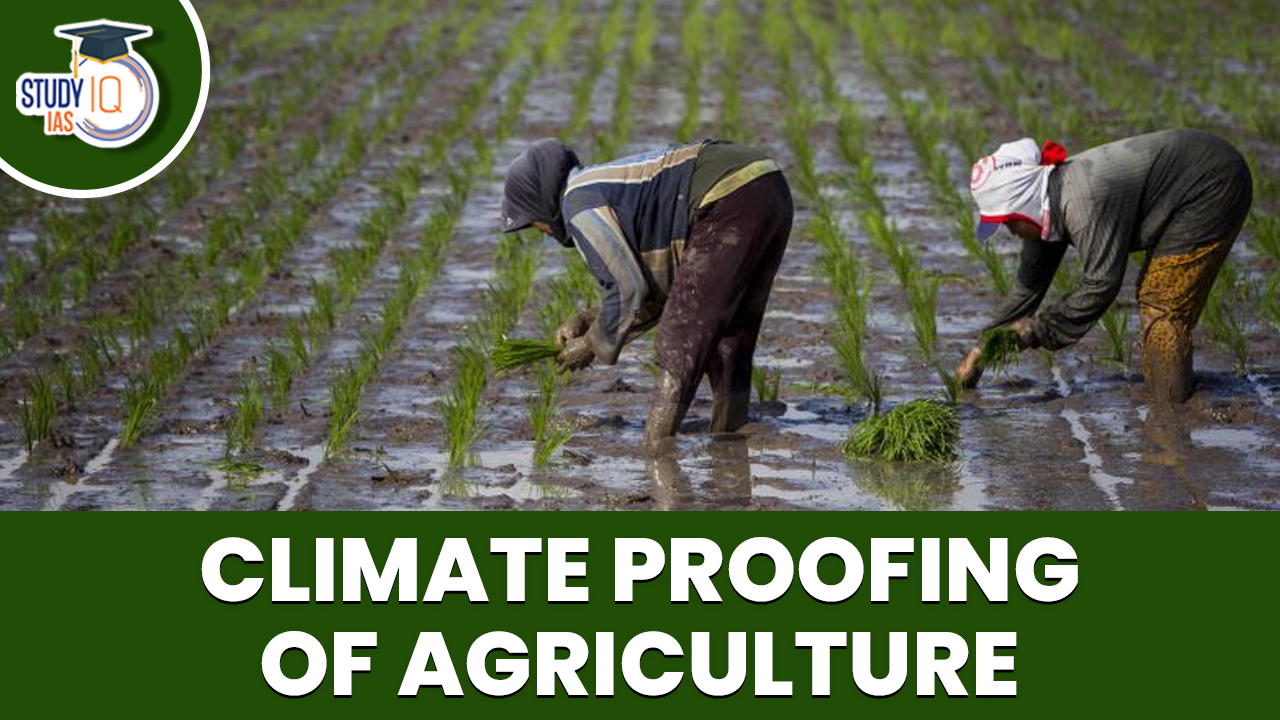Table of Contents
Context: Given that Climate Change is posing a severe threat to agriculture and long-term food security, there is an urgent need to adopt measures.
How is Climate Change impacting agriculture?
- Reduced crop yields: Beyond a certain range of temperatures, warming tends to reduce yields because crops speed through their development, producing less grain in the process. And higher temperatures also interfere with the ability of plants to get and use moisture.
- The 2022 heatwave has resulted in an estimated 10-35 percent reduction in wheat yields in Punjab, Haryana and Uttar Pradesh.
- Impact on nutritional quality of crops: Rising levels of atmospheric carbon dioxide reduce the concentrations of protein and essential minerals in most plant species, thereby reducing the nutritional quality of crops, which is a potential threat to food security.
- Pest attacks and disease pressures: Global warming leads to more incidence of insect transmitted plant diseases through range expansion and rapid multiplication of insect vectors.
- According to World Economic Forum (WEF), with every increase in one degree of global warming, losses of crops to insects will increase from 10% to 25%.
- The warming of the Indian Ocean due to climate change is cited as the main reason for the 2019–2020 locust attacks across Rajasthan, Gujarat and Punjab
- Livestock productivity: Heat stress affects livestock both directly and indirectly.
- Over time, heat stress can increase vulnerability to disease, reduce fertility, and reduce milk production.
- Drought may threaten pasture and feed supplies. Drought reduces the amount of quality forage available to grazing livestock.
- Impact on fisheries: In addition to warming, the oceans are gradually becoming more acidic due to increases in atmospheric carbon dioxide.
- Due to ocean warming, there will be more species migration and ranges of fish species may change.
- Higher water temperatures lead to more marine disease outbreaks.
- Acidification also threatens sensitive ecosystems such as coral reefs upon which several species rely.
- Extreme events: With the global warming, there has been an increase in the intensity and frequency of extreme events such as floods, droughts, heatwaves, and landslides etc., which can destroy standing crops and reduce yields.
|
Climate crisis has cost India 5 million hectares of crop area in 2021:
|
- Impact on farmer’s income: The Economic Survey 2017-18 highlighted that “Climate change could reduce annual agricultural incomes in the range of 15% to 18% on an average, and up to 20% to 25% for unirrigated areas”.
Important Climate Proofing Solutions for Agriculture
- Climate smart agriculture (CSA): It is an integrated approach to managing landscapes—cropland, livestock, forests and fisheries–that address the interlinked challenges of food security and climate change. The three pillars of CSA are as follows:
- Increased productivity: Produce more and better food to improve food security and boost incomes.
- Enhanced resilience: Reduce vulnerability to drought, pests, diseases and other climate-related risks and shocks.
- Reduced emissions: Pursue lower emissions for each calorie or kilo of food produced, avoid deforestation from agriculture.
- Precision farming: It is an approach where inputs are utilized in precise amounts to get increased average yields, compared to traditional cultivation techniques.
- It is based on using Information and Communication Technologies (ICTs). It will result in more efficient irrigation, high Nutrition Use Efficiency (NUE), and less soil degradation etc.
- Other climate resilient agricultural practices: Include Integrate crop livestock systems, Conservation Tillage, Adaptation of climate resilient crop varieties, agroforestry and agroecological practices such as intercropping, crop rotation, and organic farming, dryland agriculture etc.
Initiatives for climate proofing of agriculture in India
- National Mission on Sustainable Agriculture:
- Launched in 2014-15, it is one of the eight missions under the National Action Plan on Climate Change (NAPCC).
- It seeks to transform Indian agriculture into a climate resilient production system through suitable adaptation and mitigation measures in the domain of crops and animal husbandry.
- National Innovations on Climate Resilient Agriculture (NICRA): Initiated by the ICAR in 2011 to enhance resilience of Indian Agriculture to climate vulnerability through strategic research and technology demonstration.
- Pradhan Mantri Krishi Sinchayee Yojana (PMKSY): envisages “Per Drop More Crop”, that is, promoting micro/drip irrigation to conserve water.
- ICRISAT (International Crops Research Institute for the Semi-Arid Tropics) has also developed a pool of approaches for building climate smart villages such as:
- Watershed management approach (improving rural livelihoods by rehabilitating natural ecosystems);
- Futuristic multi-model approach (Customizing adaptation packages to enhance climate resilience);
- Digital technologies approach (by integrating climate information and eco-conservation technologies);
- Meteorological advisory and farm systems approach (building resilience agro-ecosystems by using climate information);
- Climate and crop-modelling approach (cropping advisories based on seasonal forecasts).
Challenges for climate proofing of agriculture in India
- Small and fragmented land-holdings: More than 58 per cent of operational holdings in the country have size less than one hectare, which acts as an impediment to adoption of technology into farms.
- Poor adoption of ICT in agricultural sector: Due to poor connectivity and infrastructure in rural areas; lack of capacities of rural population to engage with ICTs; challenges in optimizing returns of investment in ICTs, etc.
- Rural divide: Low levels of e-literacy, digital skills, affordability, infrastructure, as well as access to services in rural areas as compared to urban areas.
- Bias against small and marginal farmers: Most of the commercial applications in agriculture, such as precision farming or drones, have not been designed to serve the needs of the most vulnerable i.e. the small farmers.
- Lack of synergy: Among various levels of government regarding climate policy framework for agriculture. For E.g. there is a least appreciation of a changing climate at the level of local self-governments.
Way forward
- Capacity building: Rationale of climate-smart agriculture (CSA) should be appreciated by decision makers at all levels. There should be structured trainings to officials of relevant Departments to sensitize them to understand diverse impacts of global climate change even at local levels.
- Localization of goals: Allocations under MGNREGA can be purposefully utilized in climate-proofing projects such as farm ponds; soil and water management through participatory watershed approaches; plantation and agro-forestry; and many other eco-friendly activities that will adapt and build resilience to climate change.
- Funding: Public investment in agricultural research, irrigation, extension services, and climate-smart agricultural practices should be increased.
- R&D: Priority has to be accorded for upscaling research on emerging areas of climate science to develop technologies that must include pest-surveillance and forewarning systems; simulation modelling and big data analytics, etc.
- Access to knowledge: Farmers must gain access to the rich scientific knowledge recommended by various research institutions/projects through efficient dissemination of the climate-smart technologies.
Conclusion: Climate proofing of agriculture is necessary for reducing hunger and poverty in the face of climate change, and to achieve majority of the 17 SDGs. The effects of climate change on the ‘complex and risk prone’ farming systems of India will be disastrous, if ‘climate-wise’ development policies are not implemented with focus and regularity.


 Personality Rights in India: Expanding P...
Personality Rights in India: Expanding P...
 Judicial Recognition of Child Traffickin...
Judicial Recognition of Child Traffickin...
 Misrepresentation and Fraud in Digital T...
Misrepresentation and Fraud in Digital T...

























